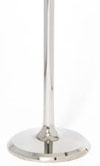Smooth surface treatments
 Leading crankshaft manufacturer, Arrow Precision Ltd, of Hinckley, Leicestershire, have recently expanded their capabilities by installing a rigid polishing machine for use on main and crankpin journals.
Leading crankshaft manufacturer, Arrow Precision Ltd, of Hinckley, Leicestershire, have recently expanded their capabilities by installing a rigid polishing machine for use on main and crankpin journals.
Optimising journal surface finish and cylindricity is key to minimising wear and improving fatigue life. The rigid polishing system works via a precision manufactured shoe, or housing, which contacts the entire bearing journal surface to be polished. Abrasive tape is then fed into the housing and around the journal surface. The crankshaft is then rotated to generate the polishing action, whilst the shoes remain static.
The machine is also set to oscillate axially by 1 mm; this gives the finished journal a fine cross hatched pattern; which can be beneficial in terms of oil retention.
The machines can be configured to automatically feed the abrasive tape through but Arrow have found manual feeding to be entirely satisfactory thus far.
There are two main advantages which a rigid polishing machine like this one gives to a manufacturer; firstly, the ability to improve surface finish. Secondly, and perhaps most importantly, it gives them the opportunity to modify the surface profile during polishing.
For example, where customers specify a crowned journal surface, say three to four microns radially over a 40 mm journal length, then producing precision shoes to suit the task can enhance the surface profile during polishing.
Similarly, they can correct any surface profiling errors. Say for example a journal was lobed after the final grind; a standard polishing process, such as conventional nutcrackers, would follow that lobing and exaggerate it, but the process described above can directly improve the cylindricity by polishing any errors out.
Prior to installation of the new machine the company would grind the journal surfaces in the opposite direction to engine rotation, and then polish in the direction of engine rotation using conventional nutcrackers, which only has contact in two places. Polishing in the opposite direction to grinding breaks off ferrite burrs, which can potentially wipe away the oil film and cause bearing failure.
Simon Osman explained to RET Monitor that the machine does not allow standards to slip on final grind;
“The machine won’t compensate for a poor final grind. If the Ra of the component is too high post grinding the polishing machine won’t be able to correct it.
“We don’t use the polishing machine on oil seal diameters as the surface can become so smooth that the sealing lip can’t operate effectively. The end result is an excellent and consistent surface finish and cylindricity.”
From the perspective of the crankshaft designer it is important to be aware of manufacturing capabilities; surface finish can have a important influence on allowable stress levels, and bearing journal profile can be critical for managing oil film thickness along a journal, or for using rolling element bearings.
Written by Tom Sharp.